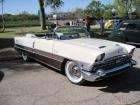Home away from home 


Joined:
2008/6/8 20:11
Last Login
:
2024/10/14 2:39
Group:
Registered Users
|
I have revived a number of old engines that had been sitting for up to 30 years.
My policy is leave everything intact as much as possible. Once you start changing things around it becomes impossible to diagnose any problems and figure out why it won't run.
Oil the cylinders by all means and take the valve covers off if possible. If any valves stick it is sometimes possible to free them off by squirting them with penetrating oil and gently prying down. With the cam out of the way of course. The valve often drops with a snap and comes free at once.
Do not use the old gas. Disconnect the fuel line at the fuel pump and attach a motorboat gas tank. If the fuel pump is not working many motorboat tanks have built in fuel pumps, you can attach them to the carb and pump them up by hand. This type tank is also a good safe means of moving a car around the yard, in and out of the garage.
If the rad is empty I like to have a pail of water on hand but not fill the rad until I know the engine is going to start. Don't forget to check the drain valve, it could have been left open when they put the car away. Also check in the rad for mice nests if they left off the rad cap.
Take off the distributor cap and check the points, if they have white fur clean it off with contact cleaner and drag a piece of 600 wet or dry sand paper between the points. Then drag a piece of white paper, folded over, between the points until they come clean.
Have the plugs out but plug them onto the plug wires. Oil the cylinders and spin the engine over on the starter until you get oil pressure. Observe the spark plugs, they should all be sparking. Put the plugs back in and be sure the plug wires are all back on the right plug. This may sound silly but it is a very common mistake, surprisingly easy to do. The resulting misfire or rough running is hard to diagnose because it could be anything.
Most engines can be got running with a little work. The only one that completely stymied me was a 1951 Land Rover that had been parked outside with the hood up,and the air filter off for years. It was seized so bad a safe cracker couldn't have got it running.
Once you get the engine running it's time to think of new coolant, oil change, cleaning the pan, and tuning the engine. The more you drive them the better they run as a rule. But many stops and starts and idling in the garage will foul up a old engine with carburetor and points ignition. So it's best not to start the engine unless you have time to warm it up thoroughly.
Posted on: 2008/9/9 20:38
|









